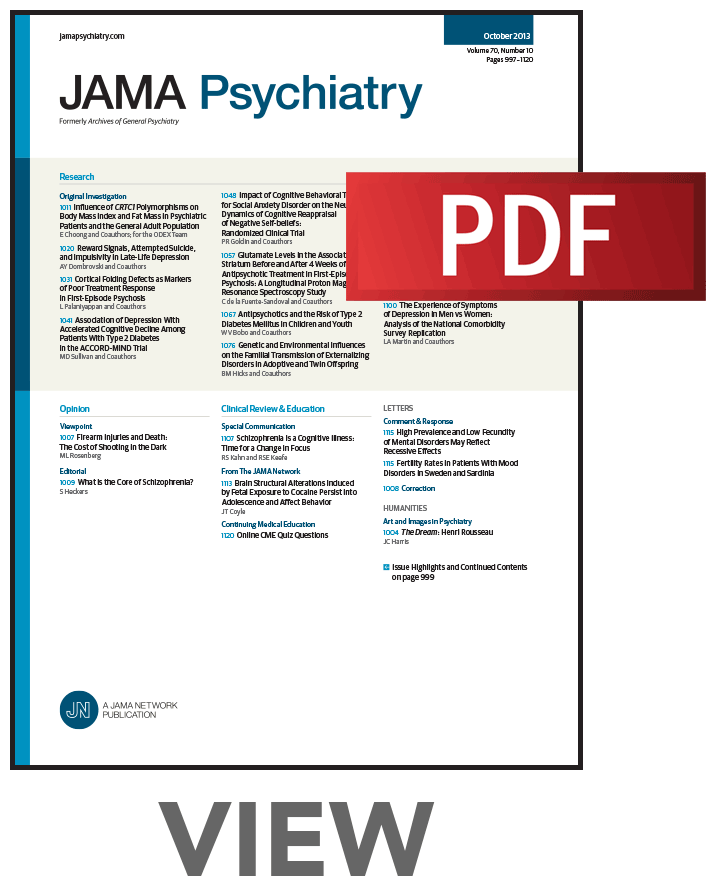多基因对单极抑郁症锂离子治疗结果的影响
IF 17.1
1区 医学
Q1 PSYCHIATRY
引用次数: 0
摘要
重要性:对于抗抑郁反应不足的重度抑郁症患者,锂离子增强治疗是一种有效的治疗方法,但治疗结果在个体之间差异很大。分子研究可能为治疗预测和指导个性化治疗提供新的见解。目的探讨锂离子强化治疗后精神分裂症(SCZ)、重度抑郁症(MDD)和双相情感障碍(BIP)多基因风险评分(PRS)与临床预后的关系。设计、环境和参与者本队列研究前瞻性地分析了接受锂离子增强治疗的患者的治疗结果。疾病特异性PRS采用全基因组关联研究汇总统计计算。参与者是在2008年至2020年期间从主要在大柏林地区的13家精神病院招募的。他们是对至少一种抗抑郁药反应不足的MDD患者,在17项汉密尔顿抑郁评定量表(HAMD-17)中基线得分为12分或更高,治疗持续时间充足(≥4周),没有诊断或联合用药改变。数据分析在2022年6月至2023年11月期间进行。暴露MDD、SCZ或BIP的多基因风险评分。缓解被定义为HAMD-17评分降低50%或以上,缓解被定义为HAMD-17评分为7或以下。Cox比例风险模型,调整了祖先、人口统计学和临床协变量,用于估计有利结果的风险比(hr)。结果193例患者(平均[SD]年龄49.5[13.4]岁,女性118[61.1%]岁,男性75[38.9%]岁),较高的BIP-PRS与缓解(HR, 1.29; 95% CI, 1.02-1.63; P = 0.03)和缓解(HR, 1.52; 95% CI, 1.14-2.04; P = 0.004)相关,分别解释了2.51%和4.53%的治疗结果变异性。BIP-PRS分布中最高分位数的个体与最低分位数的个体相比,反应的可能性高2.02倍(95% CI, 1.15-3.53),缓解的可能性高2.26倍(95% CI, 1.17-4.36)。此外,较低的MDD-PRS与更好的锂离子增强反应相关(HR, 0.81; 95% CI, 0.66-1.00; P = 0.048; Nagelkerke R2 = 1.99%)。SCZ-PRS与缓解(HR, 1.00; 95% CI, 0.80-1.24; P = 0.97)或缓解(HR, 1.12; 95% CI, 0.85-1.48; P = 0.42)之间无显著关联。具有较高的BIP多基因负担和较低的MDD多基因风险的个体更有可能从锂增强治疗中获益。我们的研究结果表明,疾病相关的PRS可能有助于开发抑郁症锂增强反应的治疗预测模型,可能为临床决策提供信息。本文章由计算机程序翻译,如有差异,请以英文原文为准。
Polygenic Contributions to Lithium Augmentation Outcomes in Unipolar Depression
ImportanceLithium augmentation is an effective treatment for patients with major depression after inadequate antidepressant response, but therapeutic outcomes vary considerably between individuals. Molecular studies may provide novel insights into treatment prediction and guide personalized therapy.ObjectiveTo investigate the association of polygenic risk scores (PRS) for schizophrenia (SCZ), major depressive disorder (MDD), and bipolar disorder (BIP) with clinical outcomes after lithium augmentation.Design, Setting, and ParticipantsThis cohort study analyzed prospectively assessed treatment outcomes in patients who underwent lithium augmentation. Disorder-specific PRS were calculated using well-powered genome-wide association study summary statistics. Participants were recruited from 13 psychiatric hospitals, primarily in the greater Berlin area, between 2008 and 2020. They were patients with MDD who showed inadequate response to at least 1 antidepressant, a baseline score of 12 or more on the 17-item Hamilton Depression Rating Scale (HAMD-17), adequate treatment duration (≥4 weeks), and no diagnostic or co-medication changes. Data analysis was conducted between June 2022 and November 2023.ExposurePolygenic risk scores for MDD, SCZ, or BIP.Main Outcomes and MeasuresResponse was defined as a 50% or greater reduction in HAMD-17 score, remission as a HAMD-17 score of 7 or less. Cox proportional hazards models, adjusted for ancestry, demographic, and clinical covariates, were used to estimate hazard ratios (HRs) for favorable outcomes.ResultsAmong 193 patients (mean [SD] age, 49.5 [13.4] years; 118 [61.1%] female and 75 [38.9%] male), higher BIP-PRS were associated with both response (HR, 1.29; 95% CI, 1.02-1.63; P = .03) and remission (HR, 1.52; 95% CI, 1.14-2.04; P = .004), explaining 2.51% and 4.53% of the variability in treatment outcomes, respectively. Individuals in the highest tertile of the BIP-PRS distribution had a 2.02-fold (95% CI, 1.15-3.53) higher likelihood of response and a 2.26-fold (95% CI, 1.17-4.36) higher chance of remission compared with those in the lowest tertile. Additionally, lower MDD-PRS was associated with better response to lithium augmentation (HR, 0.81; 95% CI, 0.66-1.00; P = .048; Nagelkerke R 2 = 1.99%). No significant associations were observed between SCZ-PRS and response (HR, 1.00; 95% CI, 0.80-1.24; P = .97) or remission (HR, 1.12; 95% CI, 0.85-1.48; P = .42).Conclusions and RelevanceIndividuals carrying a higher polygenic burden for BIP and lower polygenic risk for MDD are more likely to benefit from lithium augmentation. Our findings suggest that disease-related PRS may aid in developing treatment prediction models for lithium augmentation response in depression, potentially informing clinical decision-making.
求助全文
通过发布文献求助,成功后即可免费获取论文全文。
去求助
来源期刊

JAMA Psychiatry
PSYCHIATRY-
CiteScore
30.60
自引率
1.90%
发文量
233
期刊介绍:
JAMA Psychiatry is a global, peer-reviewed journal catering to clinicians, scholars, and research scientists in psychiatry, mental health, behavioral science, and related fields. The Archives of Neurology & Psychiatry originated in 1919, splitting into two journals in 1959: Archives of Neurology and Archives of General Psychiatry. In 2013, these evolved into JAMA Neurology and JAMA Psychiatry, respectively. JAMA Psychiatry is affiliated with the JAMA Network, a group of peer-reviewed medical and specialty publications.
 求助内容:
求助内容: 应助结果提醒方式:
应助结果提醒方式:


